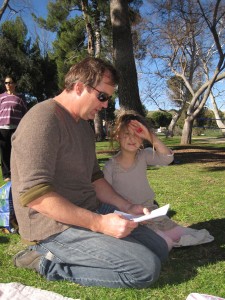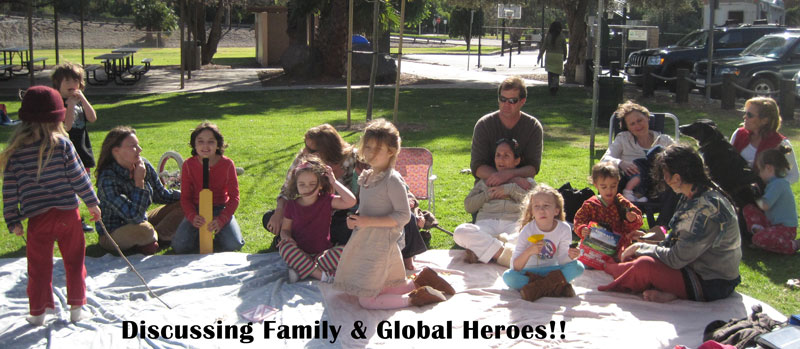
There are many books, online resources and dvds that will indoctrinate your family on the symptoms of prejudice and racism, but none will make a greater impression than those you share directly or indirectly with your children and partners. My husband and I have chosen not to teach strongly about how blacks in particular were persecuted in this country or other nations involved in the trans-atlantic slave trade. I do not want to connect the differences with color and attitudes towards friends, family and neighbors. Not at a time when they are still learning what friendship and citizenship means to them. When I discuss slavery or other forms of persecution, I speak in terms of people in power and those who were unjustly treated. When my children start asking the more specific questions, I will give them more specific answers.
Again, this is what I have chosen for my family. Your decisions will be different. Allowing every family personal freedom on this hot-topic made this Martin Luther King, Jr inspired parkday my most difficult to plan. I wanted to bring up issues of Injustice and Honor, but not in a way that would undermine the choices each family is making on their own. But my intent was to be a starting point for some.
So I chose to focus on the Heroes themselves vs the issues. I asked families to discuss what makes someone a hero and to be prepared to share when together at the park. We would all share one personal hero for each, from parents and children alike.
On the way to the park, one mother and daughter came up with three traits that they felt all REAL heroes possessed. (Thanks C & D!)
Bravery Peacefulness Caring
To that end, we added that Heroes try to change the way things are in order to help themselves, their family, their community or maybe even their country. We discussed how they did so at risk. Oftentimes at a great risk. Some never got to see their family again, some were imprisoned, some were willing to die. Some heroes chose to go against the norm or what their families wanted to do what they felt was right. At a minimum we become a hero when we risk doing something different.
Everyone was given a lot of time to share at their own pace who they thought was a hero. We heard about relatives, neighbors, teachers and even pets as heros. Other issues were brought to light when heros were involved in wars like one grandfather who fought in fighter planes. These discussions were amazing, enlightening and very positive as everyone’s input was honored.

I chose the people above to include in my email as a guessing game and briefly shared how they were deemed heroic (by wikipedia standards and my own).
From left to right:Martin Luther King Jr American clergyman, activist and prominent leader in the African-American civil rights movement. He had a dream that I am proud to say MudPies & Butterfly families expound upon in our varied communities.
Victoria Claflin Woodhull - First Female to run for President in the USA – Her 1872 campaign came at a time when women did not even have the right to vote.

Raining Diamonds by J. Deltac
Frederick Douglass - American abolitionist, women’s suffragist, editor, orator, author, statesman & reformer. (appointed to be Victoria’s Vice Presidential Running Mate – though he never acknowledged it)
Susan B. Anthony– Women’s Suffragist and immortalized on the $1 coin.
Cesar Chavez – Mexican American farm worker, labor leader , and civil rights activist who, with Dolores Huerta, co-founded the National Farm Workers Association, which later became the United Farm Workers
Anne Frank – Author of a diary that gave honest depictions of a teen’s thoughts, feelings and pacifist ideals while living in cramped quarters for 2 years from Nazi occupation. Sadly, she was captured and died of Typhoid in a concentration camp at age 15.
Nelson Mandela – Young lawyer and Civil rights activist of his native South Africa. He was imprisoned for 27 years and later elected as first president of Democratic South Africa.
Miriam Makeba (personal heroine of mine) – Singer from South Africa. First black South African to address the United Nations in person about Apartheid. Was not allowed to return to her country for decades to see family as a result. In the 90′s I painted her portrait (image on right) from her first album cover that came out in 1960 (Harry Belafonte discovered her while on tour in Africa) and affixed broken glass to represent many things, including human atrocities commenced in the name of diamond mining.
Mohandas Karamchand Gandhi – National hero of India and the world for non-violent protest. His first acts of non-violent civil disobedience occurred in South Africa where he was a lawyer. Whereas in India, one of his most striking actions was the salt march known as the Dandi March, that started on March 12, 1930 and ended on April 5, when he led thousands of people to the sea to collect their own salt rather than pay the salt tax. On May 8, 1933 Gandhi began a fast that would last 21 days to protest British ‘oppression’ in India. In Bombay, on March 3, 1939 Gandhi fasted again in protest of the autocratic rule in India.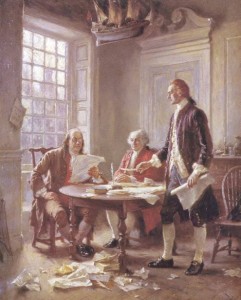
Through out history to ensure freedom and liberty ideals became laws. In 1776, founding fathers (like Benjamin Franklin) of America drafted and signed the Declaration of Independence. Here is a great video that includes the recitation of the Declaration of Independence by a star-studded cast. Morgan Freeman discusses how this document influenced Martin Luther King, Jr and others to change their world.
You will not be disappointed to click on this next link – Playing For Change: Peace Through Music – a documentary that traveled the world to show how we are all connected by Music. Many parents raved on the experience of watching this clip with their children.
I chose to read from Dr. Seuss’s Sneetches and other Stories. 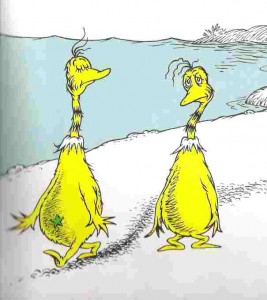 Theodor Seuss Geisel made Social criticism and commentary palatable. One will find metaphors and themes about Social Justice in most of his children’s books ! This timeless story gently speaks of the negative outcome when people discriminate based on differences instead of celebrating them. In the story, if you didn’t have a Star upon your belly, you weren’t invited to parties and were overlooked as a lesser than worthy presence. The story changes when a Money Maker comes to town and puts stars on those wanting them and collected even more money to take the stars off. In the end the Sneetches are penniless, but found a higher value in each other.
Theodor Seuss Geisel made Social criticism and commentary palatable. One will find metaphors and themes about Social Justice in most of his children’s books ! This timeless story gently speaks of the negative outcome when people discriminate based on differences instead of celebrating them. In the story, if you didn’t have a Star upon your belly, you weren’t invited to parties and were overlooked as a lesser than worthy presence. The story changes when a Money Maker comes to town and puts stars on those wanting them and collected even more money to take the stars off. In the end the Sneetches are penniless, but found a higher value in each other.
After reading Star-bellied Sneetches , I played a sticker game with the kids. I put a sticker on each child and I separated them into two groups based on differences of their stickers. One group was to laugh and point at the others. I then rearranged the groups by another trait found on some of the stickers and absent on others. This time one group was directed to walk by the other and express disgust at the smell of the others. We did this enough times so that each child had the experience of being on both sides.
, I played a sticker game with the kids. I put a sticker on each child and I separated them into two groups based on differences of their stickers. One group was to laugh and point at the others. I then rearranged the groups by another trait found on some of the stickers and absent on others. This time one group was directed to walk by the other and express disgust at the smell of the others. We did this enough times so that each child had the experience of being on both sides.
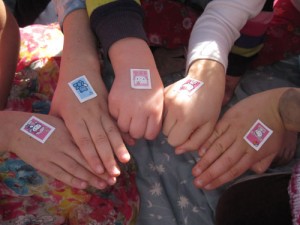 Afterward, we discussed our feelings, our reactions and the futility of not being able to do anything about the situation. We applied this to what other people at other times in the world went through this for a life time.
Afterward, we discussed our feelings, our reactions and the futility of not being able to do anything about the situation. We applied this to what other people at other times in the world went through this for a life time.
This was loosely based on Jane Elliots blue-eyed and brown –eyed experiment with her all white 3rd grade class in the 1960’s (thanks Kris)
“On that day, a Tuesday, she decided to make the blue-eyed children the superior first, giving them extra privileges like second helpings at lunch, access to the new jungle gym and five minutes extra at recess.She would not allow blue-eyed and brown-eyed children to drink from the same water fountain. She would offer them praise for being hard-working and intelligent. The “brownies” on the other hand, would be disparaged. She even made the brown-eyed children wear ribbons around their neck.”
It is awe-inspiring to think this woman was not involved in anything other than human speculation. Her pragmatic journey did alot for the world. Anyone who would like to discuss this experiment, its implications or racism, should know I invite that heady chat anytime.
I will end this blog as I did with the kids that day- with a poem by Shane DeRolf. It has been turned into book versions and can be found on many websites. The kids loved it so much they asked me to read it three times. With simple language it honors the feelings of rejection at being discriminated against as well as the feelings of having our differences embraced as well as found to be a joy to behold.
While walking into a toy store the day before today
I overheard a crayon box with many things to say
“I don’t like Red!” said Yellow and Green said “Nor do I”
“And no one here likes Orange but no one knows just why”
“We are a box of crayons that doesn’t get along
Said Blue to all the others “Something here is wrong”
Well, I bought that box of crayons and took it home with me
And laid out all the colors so the crayons all could see
They watched me as I colored with Red and Blue and Green
And Black and White and Orange and every color in between
They watched as Green became the grass and Blue became the sky
The Yellow sun was shining bright on White clouds drifting by
Colors changing as they touched becoming something new
They watched me as I colored – they watched me till I was through
And when I finally finished I began to walk away
And as I did the crayon box had something more to say
“I do like Red!” said Yellow and Green said, “so do I”
And Blue you were terrific! So high up in the sky
“We are a box of crayons each one of us unique
But when we get together the picture is more complete”
